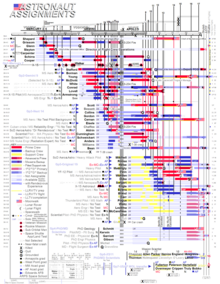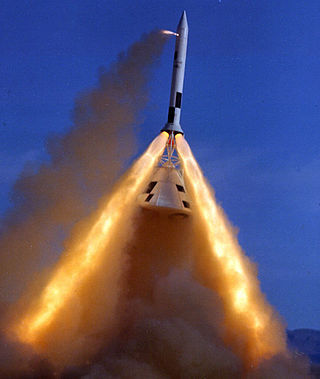This is a detailed list of human spaceflights from 1961 to 1970, spanning the Soviet Vostok and Voskhod programs, the start of the Soviet Soyuz program, the American Mercury and Gemini programs, and the first lunar landings of the American Apollo program.
Contents
- Red indicates fatalities.
- Green indicates sub-orbital spaceflight (including flights that failed to attain intended orbit).
- Grey indicates flights to the Moon.
- The United States defines spaceflight as any flight reaching an altitude of 50 miles, while the FAI definition requires an altitude of 100 kilometers. During the 1960s, 13 crewed flights of the U.S. North American X-15 rocket plane met the U.S. criteria, of which only two met the FAI's. This article's primary list includes only the latter two flights. A separate, secondary list gives the other eleven which flew between 50 miles and 100 kilometers.
| # | Crew | Launch spacecraft | Habitation | Return spacecraft | Brief mission summary | |
|---|---|---|---|---|---|---|
| 1 | | 12 April 1961 | First crewed spaceflight. Reached Low Earth Orbit (LEO), flew around the Earth one time. | |||
| 2 | | 5 May 1961 | First American crewed spaceflight. Did not reach Earth orbit, maximum altitude: 187 km (116 miles). The mission was also the first "completed" human spaceflight per past FAI definitions, because unlike Soviet Vostok 1 mission, the crew landed while remaining inside the spacecraft. [1] [2] | |||
| 3 | | 21 July 1961 | Second American crewed spaceflight. Did not reach Earth orbit, maximum altitude: 190 km (118.26 mi). | |||
| 4 | | 6 August 1961 | 7 August 1961 | Day-long flight in LEO. Flew around the Earth 17 times. Brief manual control by pilot. | ||
| 5 | | 20 February 1962 | First American crewed orbital flight. Flew around the Earth three times. It was also the first "completed" orbital human spaceflight per past FAI definitions, because unlike Soviet Vostok missions of that period, the crew landed while remaining inside the spacecraft. [2] [3] [4] [5] | |||
| 6 | | 24 May 1962 | First manual retrofire. Earth photography and study of liquids in weightless conditions. | |||
| 7 | | 11 August 1962 | 15 August 1962 | First instance of two crewed spacecraft in orbit simultaneously. | ||
| 8 | | 12 August 1962 | 15 August 1962 | First instance of two crewed spacecraft in orbit simultaneously. | ||
| 9 | | 3 October 1962 | First flawless Mercury mission. | |||
| 10 | | 15 May 1963 | 16 May 1963 | First live TV from U.S. astronaut. | ||
| 11 | | 14 June 1963 | 19 June 1963 | Longest solo spaceflight. | ||
| 12 | | 16 June 1963 | 19 June 1963 | First woman in space. | ||
| 13 | | 19 July 1963 | First winged craft in space. Reached altitude of 106 km. | |||
| 14 | | 22 August 1963 | Reached altitude of 108 km. Walker becomes first person to fly into space twice. X-15-3 (serial 56-6672) becomes first vehicle to fly into space twice. | |||
| 15 | | 12 October 1964 | 13 October 1964 | First multiple person spaceflight. Biomedical research. | ||
| 16 | | 18 March 1965 | 19 March 1965 | First EVA. | ||
| 17 | | 23 March 1965 | First to perform orbital maneuvers. | |||
| 18 | | 3 June 1965 | 7 June 1965 | First American EVA. | ||
| 19 | | 21 August 1965 | 29 August 1965 | First one week spaceflight. Cooper becomes the first person to orbit the Earth on two different missions. | ||
| 20 | | 4 December 1965 | 18 December 1965 | First two-week spaceflight. First space rendezvous in history with Gemini 6A. | ||
| 21 | | 15 December 1965 | 16 December 1965 | First space rendezvous, with Gemini 7. | ||
| 22 | | 16 March 1966 | 17 March 1966 | First docking in space in history with Agena Target Vehicle Planned EVA canceled due to early re-entry necessitated by stuck thruster. | ||
| 23 | | 3 June 1966 | 6 June 1966 | First backup crew to fly space mission. | ||
| 24 | | 18 July 1966 | 21 July 1966 | First rendezvous with two different objects. | ||
| 25 | | 12 September 1966 | 15 September 1966 | Held altitude record prior to lunar missions (1374 km). | ||
| 26 | | 11 November 1966 | 15 November 1966 | First manual rendezvous. Miscellaneous scientific experiments. | ||
| 27 | | 23 April 1967 | 24 April 1967 | Crashed on re-entry. First human fatality during a spaceflight. | ||
| 28 | | 11 October 1968 | 22 October 1968 | First three person U.S. crew. Launched over 20 months after Apollo 1 fatalities. | ||
| 29 | | 26 October 1968 | 30 October 1968 | Failed to dock with uncrewed Soyuz 2. | ||
| 30 | | 21 December 1968 | 27 December 1968 | First crewed lunar orbit. | ||
| 31 | | 14 January 1969 | 17 January 1969 | First crew transfer between space vehicles. First docking of two crewed spacecraft. | ||
| 32 | | 15 January 1969 | 17 January 1969 | First crew transfer between space vehicles. First docking of two crewed spacecraft. | ||
| | 18 January 1969 | |||||
| 33 | | 3 March 1969 | 13 March 1969 | Tested Lunar Module in low Earth orbit. | ||
| 34 | | 18 May 1969 | 26 May 1969 | Tested Lunar Module in low lunar orbit. | ||
| 35 | | 16 July 1969 | Moon | 24 July 1969 | First lunar landing. | |
| 36 | | 11 October 1969 | 16 October 1969 | First three-craft spaceflight. | ||
| 37 | | 12 October 1969 | 17 October 1969 | First three-craft spaceflight. | ||
| 38 | | 13 October 1969 | 18 October 1969 | First three-craft spaceflight. | ||
| 39 | | 14 November 1969 | Moon | 24 November 1969 | Second lunar landing. Precision landing near Surveyor 3. | |
| 40 | | 11 April 1970 | 17 April 1970 | Lunar landing aborted following explosion en route. | ||
| 41 | | 1 June 1970 | 19 June 1970 | Investigations into effects of prolonged spaceflight. Record duration mission for single spacecraft. | ||







